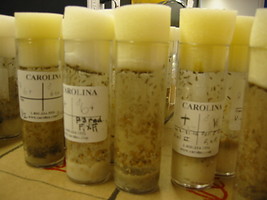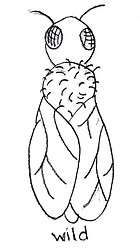Introduction:
In this project, our objective was to learn about the inheritance patterns of organisms by observing fruit flies, Drosophilia melanogaster. We used flies because they reproduce rapidly, so we were able to look at multiple generations in a short period of time. Before we started the project, we did 2 punnet squares to make a hypothesis on the genetic outcome. We thought that the vestigial mutation was autosomal recessive, and the expected phenotype ratio was 75% wild: 25% vestigial (3:1).Characteristics:
Fruitflies are in the Arthropoda phylum and Insecta class. Arthropoda have jointed appendages (limbs), an exoskeleton, compound eyes, an open circulatory system, antennae, concentration of sensory and brain structure, and most have mandibles.
Those in the insecta class have three body segments (the head, thorax, and abdomen).They also have mandibles, 1 pair of antennae, 3 pairs of legs on the thorax, 9-11 segments on the abdomen and most have 1 or 2 pair of wings. Insecta have a short life span and fast reproduction.
Phenotypes of our flies
White Eyes: This fly has white eyes
Vestigial: This fly's wings are small and shriveled and look like ugly little prunes, and this is the mutation that we chose to observe for our cross
Wild: This fly has red eyes and normally shaped, full bodied, and large wings
Group Life Cycle Log
P1 Generation
2/27/06: Flies expand to new cultures
3/3/06: Small brown dot is the visible brain of the larva. They're burrowing and eating the medium
3/6/06: A few of the larvae have become small flies. Most of them are still larvae that are clinging to the sides of the vial.
3/8/06: The larvae are a bit bigger, but there's a lot of babies crawling around the medium.
3/9/06: Many are still pupas, a few flies have hatched, still little babies everywhere.
3/10/06: Some of the pupas are turning brown, which means they're about to hatch.
3/13/06: Most of the larva have matured into flies and about half of them are still larvae preparing to become flies.
F1 Generation:
3/16/06: The vial has the flies that we put in; all are alive and no larvae yet
3/17/06: All 12 original flies are alive and the females have enlarged back ends appearing to be pregnant.
3/20/06: Larvae is evident in both vials.
3/21/06: Many larvae are present and they seem ready to hatch. The original flies are no longer as fat.
3/23/06: There seem to be fewer flies in both viles but many pupa. They have food tunnels in the medium.
3/24/06: None of the pupae have hatched but they are all dark and look like they are about to hatch.
3/27/06: All of the hatched flies in vial one are wild. In vial two, there are some vestigial, but mostly wild.
3/28/06: More pupae hatched. Vial 1 is all wild, and vial 2 is mostly wild with some vestigial.
3/29/06: Most larvae have hatched in both vials, and most flies are wild.
F2 Generation:
4/3/06: Nothing has happened yet
4/7/06: The F1's are removed from the vials, leaving us with a new generation. Unfortunately, most of these flies are dead.
4/17/06: Most flies are wild, but there are some vestigial in each vial. There are still some pupae that need to hatch.
4/21/06: In vial 2, there are many pupae, but no hatched flies.
4/24/06: There are now a ton of newly hatched flies in both vials.
Sexing the flies:
In order to sex the flies, you have to look for a few main characteristics. Generally the females have a larger back end than the male, and the males have a prominant black dot on their back end. The females also have the black dot on their back end, but its considerably lighter than that of a male.
F1 Predictions:
In our fruit fly experiment, we used 4 different kinds of flies, mated them, and waited to see what kind of flies come out. We have made a series of predictions as to what kind of flies we think will come out of the 2 vials. In one vial, we have wild females, and vestigial males. In the other, we have vestigial males, and wild females. In our first autosomal hypothesis, assuming vestigial is dominant and wild recessive, 100% of the offspring will come out with vestigial wings and heterozygous.
Vestigial male crossed with a wild female:
(If the mutation for vestigial is dominant)
Vestigial male crossed with wild female.
| + | + | |
| vg | vg+ | Vg+ |
| vg | vg+ | vg+ |
| vg | vg | |
| + | vg+ | vg+ |
| + | vg+ | vg+ |
F1 Outcomes:
Most of our flies turned out to be wild, although we had a few vestigial because of a contamination with the males.
F2 Predictions
(Vial 1) F1 Cross= Phenotype: wild male (genotype=+vg)X Phenotype: wild female (+vg)
| + | vg | |
| + | ++ | + vg |
| vg | +vg | vg vg |
% Phenotypes in F2 offspring: 75% wild, 25% vestigial
% Genotypes in F2 offspring: 25% ++, 50% ,+vg, 25% vg vg
(Vial 2) F1 Cross= wild female (genotype +vg) X wild male (genotype +vg)
| + | vg | |
| + | ++ | + vg |
| vg | +vg | vg vg |
% Phenotypes in F2 offspring: 75% wild, 25% vestigial
% Genotypes in F2 offspring: 25% ++, 50% +vg, 25% vg vgF2 Outcome:
| Vial 1 | Total:40 | Female wild:18 | Male wild:17 | Female vg:0 | Male vg:5 |
| Vial 2 | Total:111 | Female wild:32 | Male wild:44 | Female vg:20 | Male vg:15 |
Conclusion
Our original hypothesis was a 3:1 ratio (75% wild: 25% vestigial). Based on our percent error, this hypothesis was correct for vial 2, but not vial 1. This was most likely because there was contamination in vial 1. The flies from the F1 generation got stuck in the medium, so they weren't removed during clearing. If we were to do this experiment again, we would put the vials on their sides after napping the flies, to prevent them from getting stuck in the medium. Some things that we noticed that lead to a question was, whether or not wild flies breed faster than vestigial flies? Was this just because the ration was higher? We also wondered about the fly's tolerance to their own feces. Humans get sick from this, but the flies seemed to be able to live in theirs and not have any complications.
Rest In Peace Little Flies
3/16/2006-3/23/2006
Undeserving of the horrible
Death by alcohol that you received.
We didn't want to kill you guys, but we were forced to do so...
Rest in peace you will be missed.







 Go to quick links
Go to quick search
Go to navigation for this section of the ToL site
Go to detailed links for the ToL site
Go to quick links
Go to quick search
Go to navigation for this section of the ToL site
Go to detailed links for the ToL site